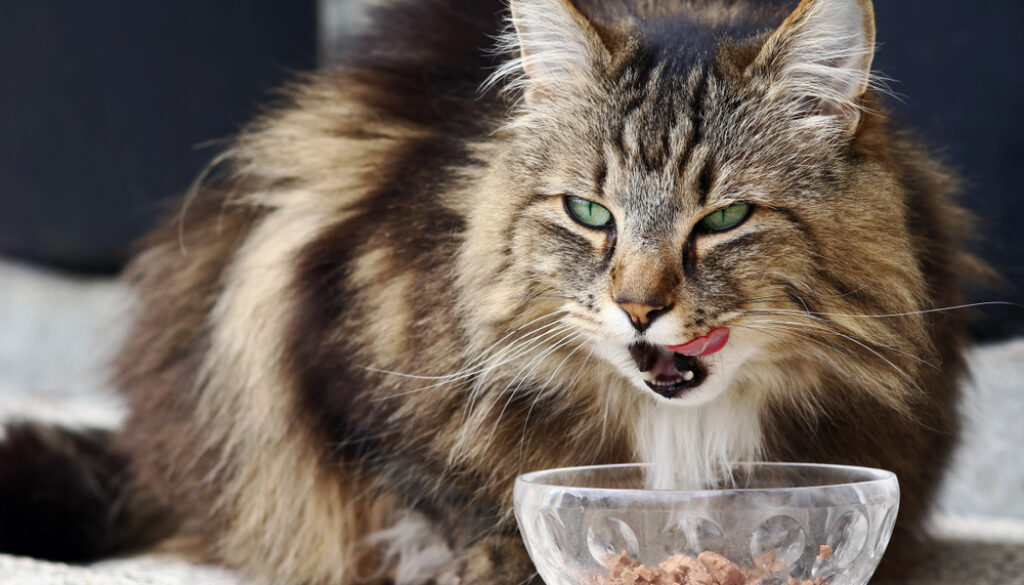Feeding Your Norwegian Forest Cat: Dietary Needs and Nutritional Recommendations
Norwegian Forest Cats are beautiful and majestic creatures known for their strong build and thick, water-repellent coats. As a pet parent of a Norwegian Forest Cat, it is essential to understand and meet their dietary needs to ensure they lead a healthy and happy life.
Norwegian Forest Cats are an ancient breed of domesticated cats that originated in Norway. They are well-known for their friendly and sociable nature, making them great companions for families. Due to their unique genetic makeup and active lifestyle, Norwegian Forest Cats have specific dietary requirements that must be met to maintain their overall health and well-being.
Understanding the Dietary Needs of Norwegian Forest Cats
Norwegian Forest Cats have unique dietary requirements that differ from other cat breeds. Due to their large size, muscular build, and active nature, Norwegian Forest Cats need a diet that is rich in protein to support their muscle development and energy levels. Additionally, they require a good source of fats to maintain their skin and coat health.
Protein is an essential component of a Norwegian Forest Cat’s diet as it helps to build and repair tissues, muscles, and organs. Look for cat foods that list a high-quality protein source, such as chicken, turkey, or fish, as the first ingredient. Avoid foods that contain excessive fillers and carbohydrates, as these provide little nutritional value for your cat.
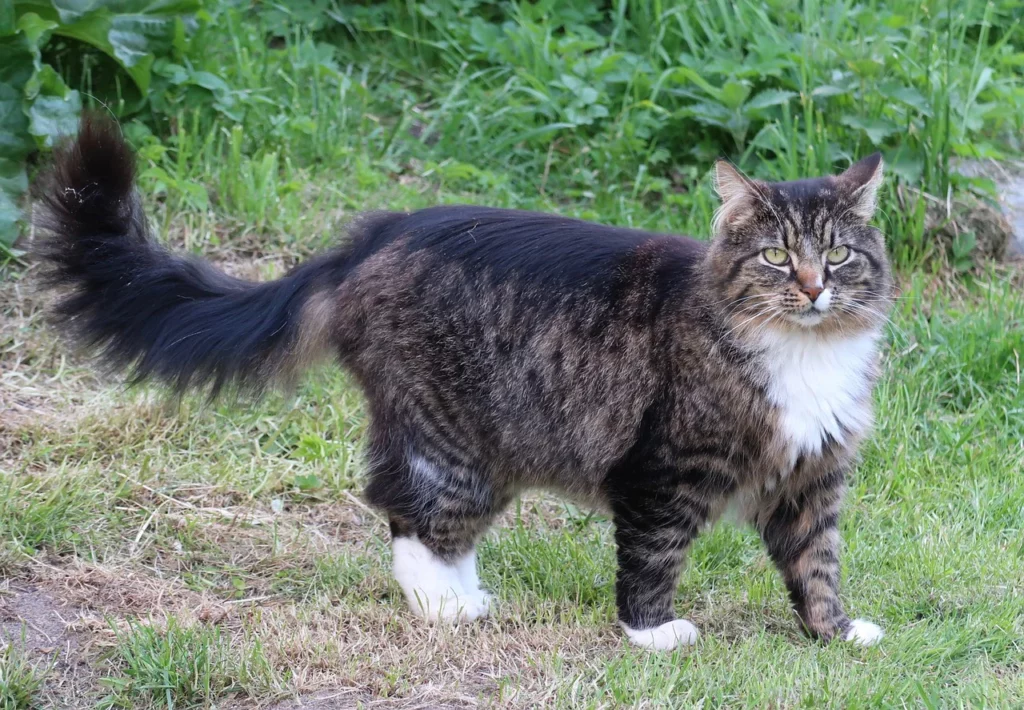
In addition to protein, Norwegian Forest Cats also require a moderate amount of fat in their diet. Fats are a concentrated source of energy and are essential for healthy skin and coat. Look for cat foods that contain omega-3 and omega-6 fatty acids, which are important for maintaining your cat’s coat luster and skin health.
Carbohydrates should make up a small portion of a Norwegian Forest Cat’s diet, as they are obligate carnivores and do not require a high carbohydrate intake. Look for cat foods that contain complex carbohydrates, such as fruits and vegetables, rather than simple carbohydrates like corn or wheat.
It is important to provide your Norwegian Forest Cat with a well-balanced diet that meets all of their nutritional needs. Consult with your veterinarian to determine the best feeding plan for your cat based on their age, weight, activity level, and any specific health concerns they may have. By understanding and meeting the dietary needs of your Norwegian Forest Cat, you can help them live a long and healthy life.
Importance of a Balanced Diet
A balanced diet is crucial for the overall health and well-being of Norwegian Forest Cats. Providing your cat with a diet that is nutritionally complete and balanced ensures that they receive all the essential nutrients they need to thrive. A balanced diet helps support your cat’s immune system, digestive health, energy levels, and overall vitality.
Norwegian Forest Cats, like all other cat breeds, require a mix of proteins, fats, carbohydrates, vitamins, and minerals to stay healthy. Proteins are essential for building strong muscles, repairing tissues, and supporting overall growth and development. Fats provide a concentrated source of energy for your cat and are important for maintaining healthy skin and a shiny coat.
Carbohydrates, while not a primary component of a cat’s diet, can provide a source of fiber and energy. However, it is essential to choose complex carbohydrates from sources such as fruits and vegetables, rather than simple carbohydrates like corn or wheat. Providing a balanced mix of these macronutrients helps ensure that your cat receives all the necessary nutrients for optimal health.
In addition to macronutrients, Norwegian Forest Cats require specific vitamins and minerals to support various bodily functions. For example, taurine is an essential amino acid for cats that plays a crucial role in their heart health and vision. Make sure that your cat’s diet includes adequate amounts of essential vitamins and minerals to prevent deficiencies and maintain overall health.
By feeding your Norwegian Forest Cat a balanced diet, you can help prevent nutritional deficiencies, maintain a healthy weight, and support their overall well-being. Consult with your veterinarian to develop a feeding plan that meets your cat’s specific nutritional needs and dietary preferences.
Nutritional Guidelines for Norwegian Forest Cats
When it comes to choosing the right food for your Norwegian Forest Cat, there are several key nutritional guidelines to keep in mind. Here are some important factors to consider when selecting cat food for your furry friend:
- Protein Content: Norwegian Forest Cats require a diet that is high in protein to support their muscle development and energy levels. Look for cat foods that list animal-based proteins, such as chicken, turkey, or fish, as the primary ingredients.
- Fat Content: Fats are essential for Norwegian Forest Cats to maintain healthy skin and a shiny coat. Choose cat foods that contain healthy fats, such as omega-3 and omega-6 fatty acids, to support your cat’s overall health.
- Avoid Fillers: Avoid cat foods that contain excessive fillers, such as corn, wheat, and soy, as these provide little nutritional value for your cat. Opt for foods that are free from artificial preservatives, colors, and flavors.
- Nutrient Balance: Ensure that your cat’s food provides a balance of essential nutrients, including vitamins and minerals. Consult with your veterinarian to ensure that your cat’s diet meets all of their nutritional needs.
- Hydration: Norwegian Forest Cats are prone to urinary tract issues, so it is important to keep them well-hydrated. Consider incorporating wet food into your cat’s diet to increase their moisture intake.
- Feeding Schedule: Establish a regular feeding schedule for your Norwegian Forest Cat and practice portion control to prevent overeating and obesity. Monitor your cat’s weight and adjust their food intake as needed.
By following these nutritional guidelines and providing your Norwegian Forest Cat with a balanced and nutritious diet, you can help them lead a healthy and happy life. Always consult with your veterinarian if you have any questions or concerns about your cat’s diet or nutritional needs.
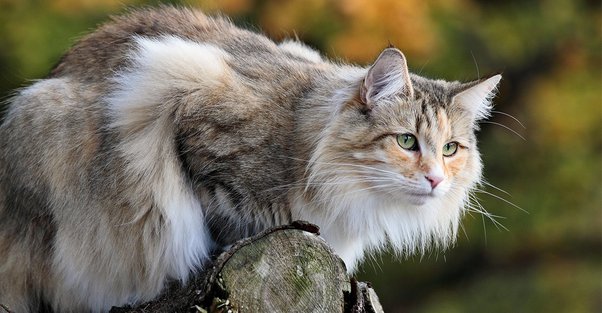
Choosing the Right Cat Food
Choosing the right cat food for your Norwegian Forest Cat is essential to their health and well-being. With so many options available, it can be overwhelming to decide which food is best for your furry friend. Here are some tips for selecting the right cat food:
- Quality Ingredients: Look for cat foods that list high-quality, animal-based proteins as the first ingredients. Avoid foods that contain by-products, fillers, artificial colors, and preservatives.
- Life Stage: Consider your cat’s age and life stage when choosing cat food. Kittens have different nutritional needs than adult cats, so make sure you select a food that is appropriate for your cat’s age.
- Special Considerations: If your Norwegian Forest Cat has specific health issues or dietary restrictions, look for cat foods that are specially formulated to address those concerns. Your veterinarian can provide recommendations for specialized diets if needed.
- Consult with Your Veterinarian: Your veterinarian is a valuable resource when it comes to choosing the right cat food for your Norwegian Forest Cat. They can provide personalized recommendations based on your cat’s individual needs and preferences.
By selecting a high-quality cat food that meets your cat’s nutritional requirements, you can help ensure that your Norwegian Forest Cat maintains optimal health and vitality.
Raw Food Diet vs. Commercial Cat Food
When it comes to feeding your Norwegian Forest Cat, you may be considering whether to feed a raw food diet or commercial cat food. Both options have their pros and cons, and the decision ultimately depends on your cat’s individual needs and your preferences. Here are some considerations for each type of diet:
Raw Food Diet:
- Proponents of raw food diets believe that they mimic a cat’s natural diet in the wild and provide numerous health benefits.
- Raw food diets often consist of raw meat, bones, organs, and vegetables, and can be prepared at home or purchased commercially.
- It is essential to carefully plan and balance a raw food diet to ensure that your cat receives all the necessary nutrients.
- Some cats thrive on raw food diets and may experience improved digestion, healthier coats, and increased energy levels.
Commercial Cat Food:
- Commercial cat food is convenient, readily available, and formulated to meet the nutritional needs of cats.
- There are several types of commercial cat food, including dry kibble, wet food, and semi-moist food, each with its own advantages.
- Look for high-quality commercial cat food that lists meat as the primary ingredient and is free from artificial colors, preservatives, and fillers.
- Commercial cat food is regulated and undergoes testing to ensure that it meets the nutritional standards set by organizations like the Association of American Feed Control Officials (AAFCO).
Ultimately, the decision between a raw food diet and commercial cat food depends on your cat’s preferences, dietary needs, and your comfort level with preparing or purchasing specialized diets.
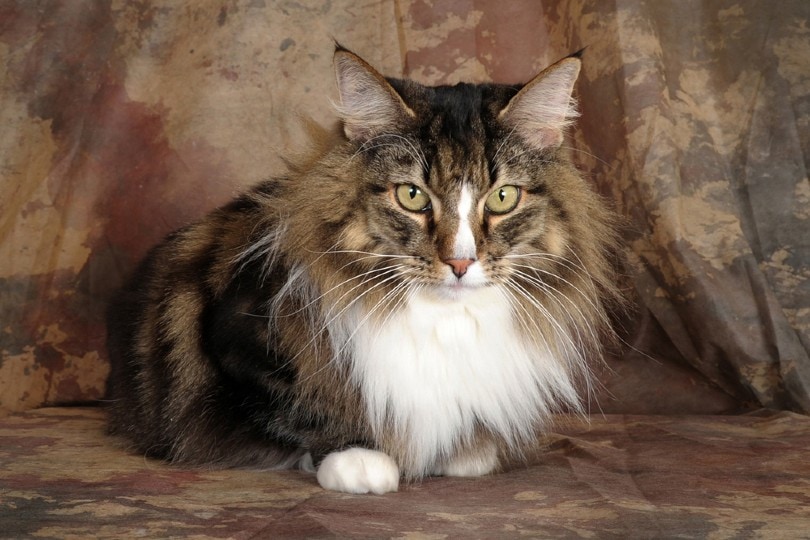
Feeding Frequency and Portion Control
Establishing a feeding schedule and practicing portion control is essential for maintaining your Norwegian Forest Cat’s health and weight. Here are some tips for feeding frequency and portion control:
- Regular Feeding Schedule: Establish a consistent feeding schedule for your cat, with set mealtimes each day. Stick to the same schedule to help regulate your cat’s digestion and prevent overeating.
- Portion Control: Measure out your cat’s food portions to ensure they are receiving the appropriate amount of food each day. Consult with your veterinarian to determine the right portion size for your cat based on their age, weight, and activity level.
- Divide Meals: Consider dividing your cat’s daily food allowance into multiple smaller meals throughout the day. This can prevent binge eating and help maintain stable blood sugar levels.
- Monitor Weight: Regularly weigh your cat and monitor their body condition to ensure they are maintaining a healthy weight. Adjust their food portions as needed to prevent obesity or underweight.
By establishing a feeding schedule, practicing portion control, and monitoring your cat’s weight, you can help ensure that your Norwegian Forest Cat maintains a healthy diet and lifestyle. Consult with your veterinarian if you have any questions or concerns about feeding frequency and portion control specific to your cat’s needs.
Hydration Needs for Norwegian Forest Cats
Hydration is essential for all cats, including Norwegian Forest Cats, as it plays a crucial role in maintaining overall health and well-being. Proper hydration helps support various bodily functions, such as digestion, circulation, and temperature regulation. Here are some tips to ensure your Norwegian Forest Cat stays properly hydrated:
- Fresh Water: Always provide your cat with access to fresh, clean water. Make sure to change the water regularly to encourage your cat to drink more.
- Multiple Water Sources: Place multiple water bowls around your home to make it easier for your cat to access water throughout the day. Some cats prefer running water, so consider a cat fountain to encourage drinking.
- Wet Food: Consider incorporating wet food into your cat’s diet, as it has a higher moisture content compared to dry kibble. Wet food can help increase your cat’s overall water intake.
- Monitor Hydration: Pay attention to your cat’s water intake and urine output to ensure they are staying properly hydrated. Signs of dehydration in cats include dry gums, sunken eyes, and lethargy.
By taking steps to ensure your Norwegian Forest Cat stays hydrated, you can help promote their overall health and prevent issues related to dehydration.
Common Dietary Issues in Norwegian Forest Cats
While Norwegian Forest Cats are generally healthy and robust breeds, they may be prone to certain dietary issues that can affect their health. Some common dietary issues in Norwegian Forest Cats include:
- Urinary Tract Issues: Norwegian Forest Cats may be prone to urinary tract problems, such as bladder stones or urinary blockages. Providing ample hydration and a balanced diet can help prevent urinary issues.
- Obesity: Due to their large size and hearty appetites, Norwegian Forest Cats may be at risk for obesity if not fed and portion-controlled properly. Obesity can lead to various health issues, such as diabetes and joint problems.
- Food Allergies: Some Norwegian Forest Cats may have sensitivities or allergies to certain ingredients in their food. Common allergens in cat food include grains, dairy, and certain proteins. Consult with your veterinarian if you suspect your cat has a food allergy.
- Sensitive Digestion: Norwegian Forest Cats may have sensitive stomachs or digestive systems, leading to issues such as vomiting, diarrhea, or food intolerance. Opting for high-quality, easily digestible cat food can help alleviate these problems.
By being mindful of these common dietary issues and taking proactive steps to address them, you can help ensure that your Norwegian Forest Cat maintains optimal health and well-being.
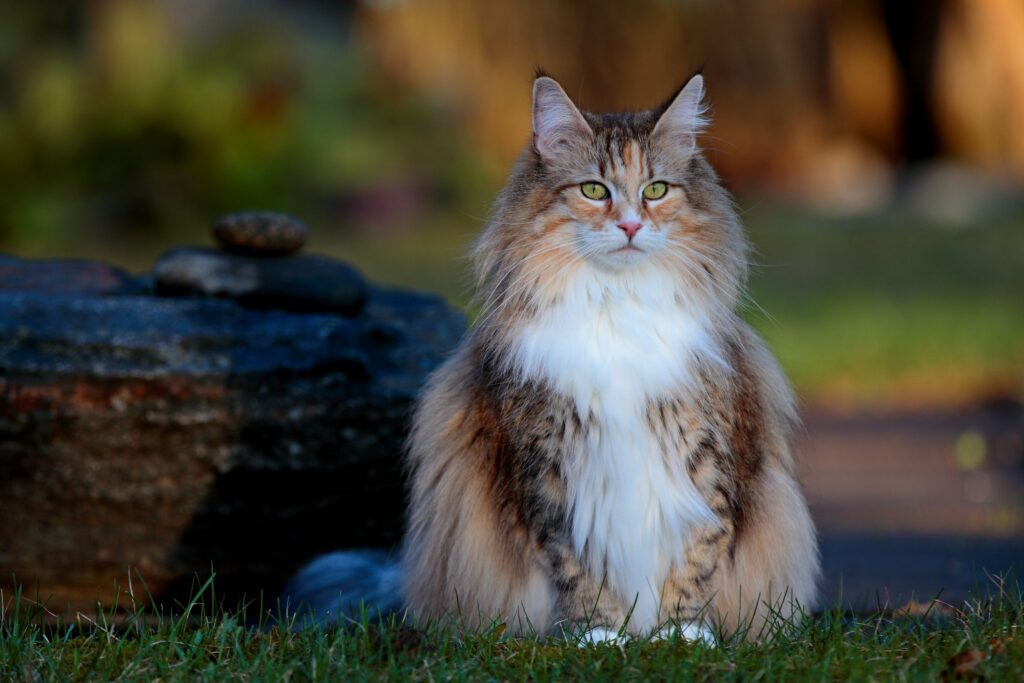
Supplements for Norwegian Forest Cats
While a well-balanced diet should provide most of the essential nutrients your Norwegian Forest Cat needs, there are certain situations where supplements may be beneficial. Consult with your veterinarian before adding any supplements to your cat’s diet, as they can provide guidance based on your cat’s individual needs. Some common supplements for Norwegian Forest Cats may include:
- Omega-3 Fatty Acids: Omega-3 fatty acids, such as fish oil, can help support your cat’s skin and coat health, reduce inflammation, and support overall wellness.
- Probiotics: Probiotic supplements can help maintain a healthy gut microbiome and support digestive health in Norwegian Forest Cats with sensitive stomachs.
- Joint Supplements: Older Norwegian Forest Cats or those with joint issues may benefit from supplements that support joint health, such as glucosamine and chondroitin.
- Multivitamins: In some cases, a multivitamin supplement may be recommended to ensure your cat is receiving all the essential vitamins and minerals they need.
Always consult with your veterinarian before introducing any supplements to your cat’s diet, as they can provide guidance on the best options and dosages for your specific cat’s needs. Monitoring your cat’s overall health and discussing any concerns with your veterinarian can help ensure that your Norwegian Forest Cat receives the necessary nutrients to thrive.
Common Dietary Issues in Norwegian Forest Cats
Norwegian Forest Cats are generally healthy and hardy breeds, but like any other cat breed, they may be prone to certain dietary issues that can affect their health. It is essential for cat owners to be aware of these common dietary issues and take steps to prevent or address them promptly. Some common dietary issues in Norwegian Forest Cats include:
- Urinary Tract Issues: Norwegian Forest Cats may be prone to urinary tract problems, such as urinary tract infections, bladder stones, or urinary blockages. These issues can be influenced by factors such as diet, hydration levels, and overall health. Providing ample hydration through wet food, multiple water sources, and regular access to fresh water can help prevent urinary tract problems.
- Obesity: Due to their large size and potentially hearty appetites, Norwegian Forest Cats may be at risk of obesity if not fed and portion-controlled correctly. Obesity can lead to various health issues, such as diabetes, joint problems, and heart disease. Monitoring your cat’s weight, providing a balanced diet, and engaging in regular exercise can help prevent obesity in Norwegian Forest Cats.
- Food Allergies or Sensitivities: Some Norwegian Forest Cats may have food allergies or sensitivities to certain ingredients in their diet. Common allergens include grains, dairy, certain proteins, or artificial additives. If you suspect that your cat has a food allergy or sensitivity, consult with your veterinarian to determine the appropriate diet for your cat.
- Sensitive Digestion: Norwegian Forest Cats may have sensitive stomachs or digestive systems, leading to issues such as vomiting, diarrhea, or gastrointestinal upset. Providing a diet rich in high-quality, easily digestible proteins and avoiding overly rich or fatty foods can help address sensitive digestion in Norwegian Forest Cats.
Addressing these common dietary issues in Norwegian Forest Cats requires careful attention to their diet, hydration levels, and overall health. Consulting with your veterinarian can help identify and manage any dietary issues your Norwegian Forest Cat may be experiencing.
Supplements for Norwegian Forest Cats
While a balanced and nutritious diet should provide most of the essential nutrients your Norwegian Forest Cat needs, there may be situations where supplementation can be beneficial. Supplements can help address specific health concerns, support overall wellness, or fill potential nutrient gaps in your cat’s diet. Here are some common supplements that may benefit Norwegian Forest Cats:
- Omega-3 Fatty Acids: Omega-3 fatty acids, such as fish oil, can help promote healthy skin and coat, reduce inflammation, and support overall cardiovascular health in Norwegian Forest Cats. Omega-3 fatty acids are particularly beneficial for cats with skin conditions, allergies, or joint issues.
- Probiotics: Probiotic supplements can help maintain a healthy balance of gut bacteria, support digestion, and promote gastrointestinal health in Norwegian Forest Cats with sensitive stomachs or digestive issues.
- Joint Supplements: Older Norwegian Forest Cats or those with joint problems may benefit from joint supplements containing ingredients like glucosamine and chondroitin. These supplements can help support joint health, reduce inflammation, and improve mobility in cats with arthritis or joint stiffness.
- Multivitamins: In certain cases, a multivitamin supplement may be recommended to ensure that your Norwegian Forest Cat is receiving all the essential vitamins and minerals necessary for optimal health. Multivitamins can help fill nutrient gaps in your cat’s diet and support overall well-being.
Before adding any supplements to your Norwegian Forest Cat’s diet, it is essential to consult with your veterinarian. They can provide personalized recommendations based on your cat’s health needs, dietary habits, and any specific health conditions they may have. It is important to choose high-quality supplements formulated for cats and follow the recommended dosages to prevent any potential health risks. Regular veterinary check-ups can help monitor your cat’s health and determine if any supplements are necessary to support their well-being.
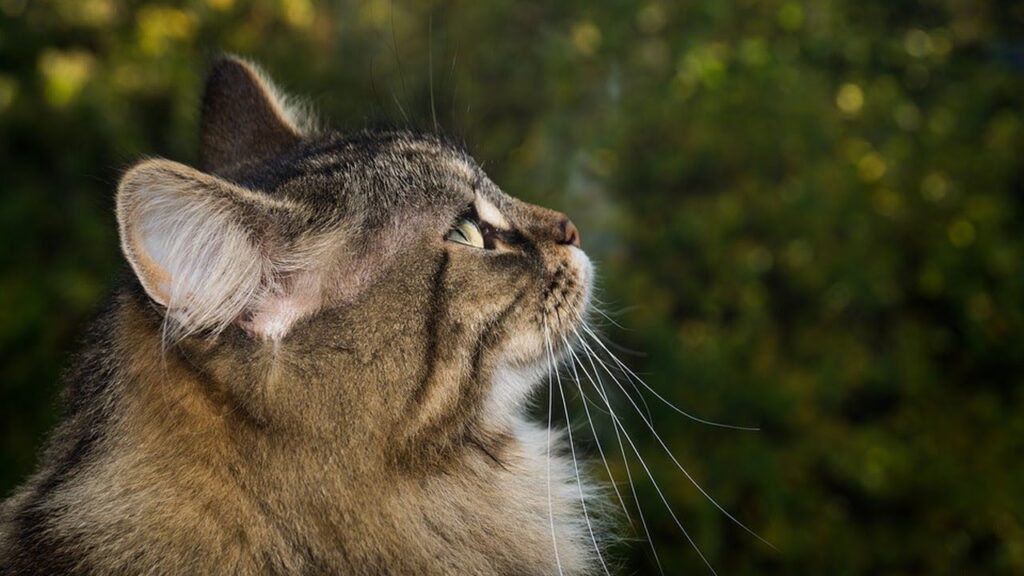
Homemade Cat Food Recipes
Making homemade cat food can be a rewarding experience and a way to ensure that your Norwegian Forest Cat is getting high-quality, nutritious ingredients. However, it is essential to consult with a veterinarian or animal nutritionist before switching to a homemade diet to ensure that it meets all of your cat’s nutritional needs. Here are two simple homemade cat food recipes that you can consider for your Norwegian Forest Cat:
Recipe 1: Homemade Chicken and Rice Cat Food
Ingredients:
- 1 pound boneless, skinless chicken thighs or breasts
- 1 cup cooked white or brown rice
- 1/4 cup cooked peas (optional)
- 1/4 cup cooked carrots, chopped (optional)
- 1-2 tablespoons chicken broth (low-sodium)
Instructions:
- Cook the chicken by boiling or grilling until fully cooked. Let it cool and then shred or chop into small pieces.
- Cook the rice according to the package instructions.
- Mix the cooked chicken, rice, peas, carrots, and chicken broth in a bowl.
- Serve the homemade cat food to your Norwegian Forest Cat once it has cooled to room temperature.
Recipe 2: Homemade Fish and Sweet Potato Cat Food
Ingredients:
- 1 can of boneless, skinless salmon or mackerel (in water, not oil)
- 1/2 cup cooked sweet potato, mashed
- 1/4 cup cooked green beans, chopped
- 1/4 cup cooked quinoa or brown rice
- 1-2 tablespoons fish broth (low-sodium)
Instructions:
- Drain the canned fish and flake it into a bowl.
- Cook the sweet potato until soft, mash it, and add it to the bowl with the fish.
- Add the cooked green beans, quinoa or brown rice, and fish broth.
- Mix all the ingredients well and serve once cooled.
Before making homemade cat food, remember to follow proper food safety practices and ensure that the ingredients are suitable for cats and do not contain any harmful additives or seasonings. Always consult with a veterinarian or animal nutritionist to ensure that your homemade cat food recipes are balanced and meet your cat’s specific nutritional requirements.
Introducing New Food to Your Norwegian Forest Cat
When introducing new food to your Norwegian Forest Cat, it is essential to do so gradually to prevent digestive upset or food aversions. Here are some tips for successfully introducing new food to your cat:
- Gradual Transition: Start by mixing a small amount of the new food with your cat’s current food. Gradually increase the proportion of the new food over several days until your cat is eating only the new food.
- Monitor for Signs of Discomfort: Watch for any signs of digestive upset, such as vomiting, diarrhea, or bloating. If your cat experiences any of these symptoms, slow down the transition process or consult with your veterinarian.
- Be Patient: Some cats may be more resistant to change and take longer to adjust to new food. Be patient and allow your cat time to acclimate to the new diet.
- Offer Variety: Cats can be picky eaters, so offering a variety of textures and flavors in their diet can help keep mealtime interesting. Rotate different types of food to keep your cat engaged and prevent food boredom.
- Consult with Your Veterinarian: If you have any concerns about introducing new food or your cat’s dietary needs, consult with your veterinarian. They can provide tailored advice and recommendations based on your cat’s individual requirements.
By following these tips and taking a gradual approach to introducing new food to your Norwegian Forest Cat, you can help ensure a smooth transition and maintain your cat’s overall health and well-being.
Signs of a Healthy Diet in Norwegian Forest Cats
A healthy diet plays a crucial role in maintaining the overall health and well-being of Norwegian Forest Cats. Here are some signs that indicate your cat is on a healthy diet:
- Healthy Weight: Your cat is at a healthy weight and maintains a stable body condition. They should have a defined waist when viewed from above and be able to feel their ribs without excess fat covering them.
- Lustrous Coat: A shiny, lustrous coat with minimal shedding is a sign of good nutrition. A healthy diet rich in essential fatty acids supports skin and coat health.
- Regular Bowel Movements: Your cat has regular, well-formed bowel movements that are not too hard or too loose. Consistent stool quality is a sign of a balanced diet.
- Healthy Appetite: Your cat has a healthy appetite and shows interest in their food. They should be eager to eat and maintain a consistent feeding schedule.
- Optimal Energy Levels: Your cat is active, playful, and maintains good energy levels throughout the day. A nutritious diet provides the energy needed for daily activities.
- Strong Immune System: A diet rich in essential nutrients supports a strong immune system, reducing the likelihood of infections and illnesses.
- Regular Veterinary Check-ups: Regular veterinary check-ups confirm that your cat is in good health and that their diet is providing all the necessary nutrients.
By observing these signs of a healthy diet in your Norwegian Forest Cat, you can ensure that they are receiving the nutrition they need to thrive.

Food Allergies and Intolerances
Food allergies and intolerances can occur in Norwegian Forest Cats, leading to various symptoms such as gastrointestinal upset, skin issues, and allergic reactions. Common signs of food allergies or intolerances in cats include:
- Skin Irritations: Itchy skin, rashes, redness, or excessive grooming can be signs of a food allergy in cats.
- Digestive Issues: Vomiting, diarrhea, flatulence, or bloating may indicate a food intolerance or sensitivity.
- Ear Infections: Chronic ear infections or inflammation can sometimes be triggered by a food allergy.
- Hair Loss: Patchy hair loss or a dull, rough coat can be a symptom of an underlying food allergy.
- Changes in Behavior: Food allergies can sometimes manifest as changes in behavior, such as increased irritability or restlessness.
If you suspect that your Norwegian Forest Cat has food allergies or intolerances, consult with your veterinarian. They can help determine the underlying cause and recommend an appropriate diet or elimination trial to identify the problematic ingredients.
Conclusion
Ensuring that your Norwegian Forest Cat is on a healthy diet is essential for their overall health and well-being. By observing signs of a healthy diet, monitoring for food allergies and intolerances, and making informed dietary choices, you can support your cat’s nutritional needs and promote a long and happy life for your beloved feline companion.
Regular veterinary care, proper nutrition, and attention to your cat’s individual dietary requirements are key factors in maintaining their health and vitality. If you have any concerns about your Norwegian Forest Cat’s diet or health, always seek guidance from your veterinarian for personalized advice and recommendations.
Also, Read:
